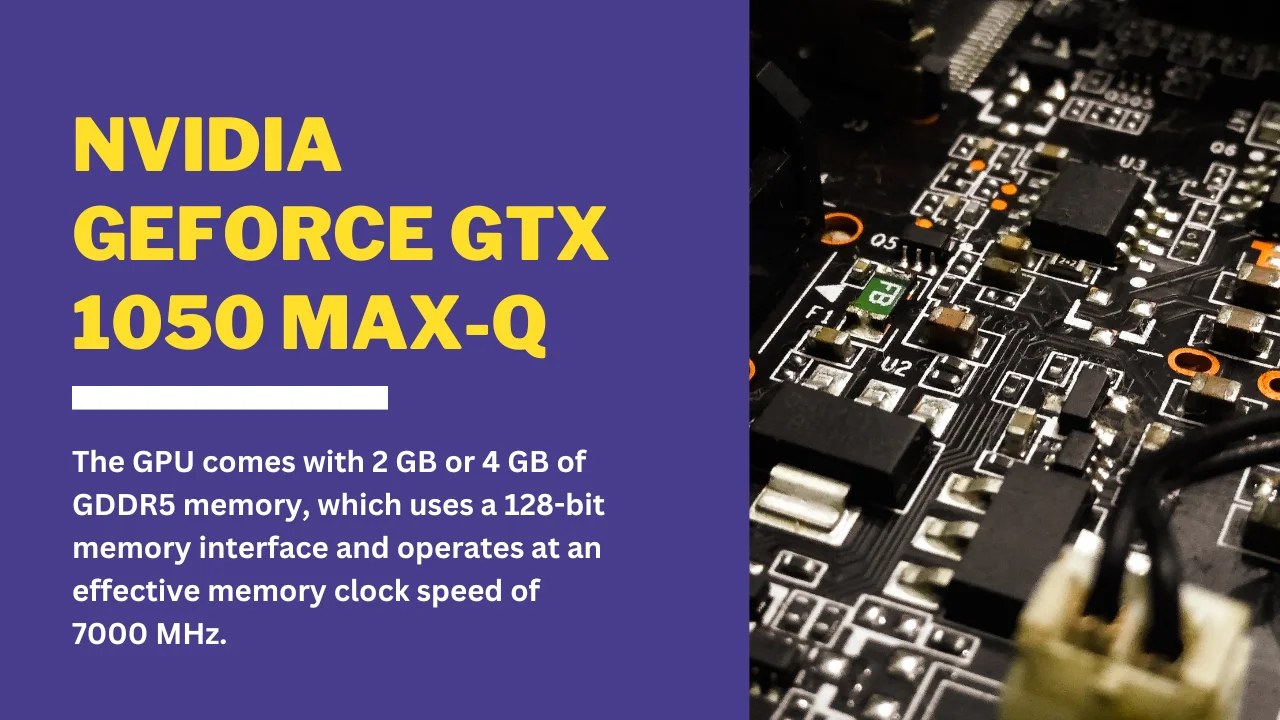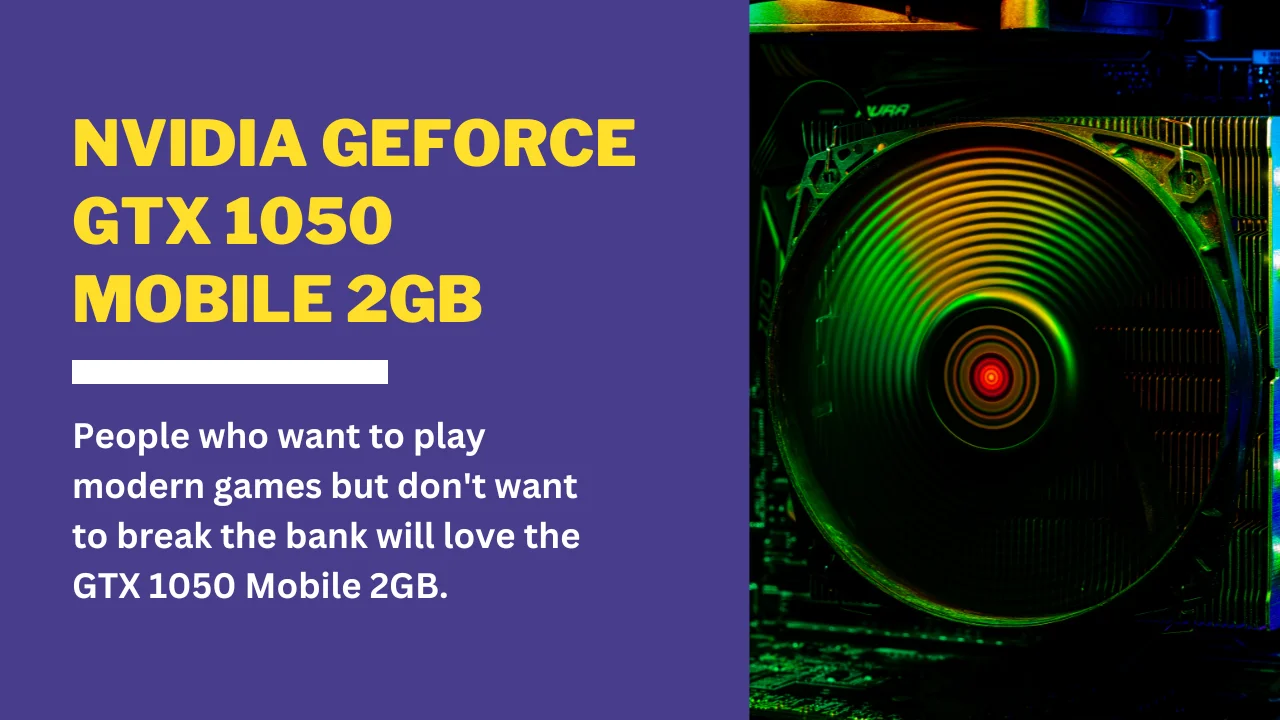For ultrabooks and other thin laptops, NVIDIA has introduced the NVIDIA GeForce GTX 1050 Max-Q, a new and impressive mobile graphics card. Using the GP107 chip, this GPU was released in January 2018 and is based on NVIDIA’s Pascal architecture. The NVIDIA GeForce GTX 1050 Max-Q is a popular option for portable computers because of its balanced performance and power efficiency, which does not sacrifice graphics capabilities.
What is the NVIDIA GeForce GTX 1050 Max-Q?
Design and Architecture
Using the famedly efficient and powerful Pascal architecture, the GTX 1050 Max-Q achieves its impressive performance while consuming very little power. This architecture supports a maximum boost clock speed of 1290 MHz and runs at a base clock speed of approximately 1151 MHz, thanks to its 640 CUDA cores. Keep in mind that the cooling solutions and power settings of your laptop will determine the exact variation in clock speeds.
Memory and Interface
The GPU comes with 2 GB or 4 GB of GDDR5 memory, which uses a 128-bit memory interface and operates at an effective memory clock speed of 7000 MHz. Thanks to its memory configuration, the GTX 1050 Max-Q is more than capable of handling today’s demanding productivity and gaming applications.
Power Consumption
The minimal power consumption is one of the most notable aspects of the Max-Q design. The GTX 1050 Max-Q has a much more modest power consumption of about 40 watts compared to its non-Max-Q equivalent. Ideal for thin and light laptops, its reduced power requirement makes it run quieter and cooler.
Performance and Capabilities
Gaming Performance
When running a number of current games at 1080p, the GTX 1050 Max-Q performs admirably. Some details about its gaming benchmarks are as follows:
Performance in Popular Games
F1 2019 When it comes to F1 2019, the GTX 1050 Max-Q is more than capable. With 1080p medium settings, it produces around 58 FPS, but with ultra settings, it drops to about 43 FPS. In particular with performance-oriented settings, this proves that the GPU can deliver a fluid gaming experience.
Double Drift 2.0 At 1080p medium settings, the GPU manages about 45.7 frames per second in Dirt Rally 2.0, and at high settings, it manages about 38.8 frames per second. The GTX 1050 Max-Q has shown itself to be capable of running demanding racing games at a satisfactory frame rate in these benchmarks.
Thermal Efficiency and Noise Levels
Laptops powered by this GPU run quietly and comfortably thanks to the Max-Q design’s focus on thermal efficiency. Reduced heat generation and quieter fan operation are two benefits of lower power consumption that improve the user experience.
Use Cases and Applications
Productivity and Creative Work
The GTX 1050 Max-Q excels at a wide variety of tasks, including gaming, productivity, and creativity. Laptops with this GPU are great for both students and professionals because of how well they handle photo and video editing software. Thanks to the GPU’s capabilities, programs like Adobe Photoshop and Premiere Pro run smoothly, letting users work on creative projects without any noticeable lag or slowdowns.
Portable Gaming Laptops
Ultrabooks and other thin laptops made for gaming often use the GTX 1050 Max-Q. Gamers who require a portable device that doesn’t skimp on graphics performance will find these laptops to be an excellent compromise between portability and gaming performance.
Comparisons and Alternatives
GTX 1050 Max-Q vs. GTX 1050
Power consumption and thermal efficiency stand out as the primary differentiating factors between the standard GTX 1050 and the GTX 1050 Max-Q. Although the Max-Q variant’s thermal characteristics are vastly improved, its performance is marginally lower due to its power-saving design. Because of this, the Max-Q version is better suited for lightweight and thin laptops, whereas the standard GTX 1050 could be a better pick for gaming laptops that have stronger cooling systems.
GTX 1050 Max-Q vs. GTX 1050 Ti
The GTX 1050 Ti outperforms the GTX 1050 Max-Q in terms of performance because it has more CUDA cores and runs at faster clock speeds. Nevertheless, it produces more heat and uses more power. Thus, ultraportable designs typically opt for the GTX 1050 Max-Q, while larger laptops with better cooling systems typically feature the GTX 1050 Ti.
Frequently Asked Questions
What is the power consumption of the GTX 1050 Max-Q?
The GTX 1050 Max-Q is designed to consume approximately 40 watts, making it an efficient choice for ultrabooks and thin laptops that prioritize battery life and thermal performance.
Can the GTX 1050 Max-Q handle video editing?
Yes, the GTX 1050 Max-Q is capable of handling video editing tasks. It performs well with software like Adobe Premiere Pro, providing smooth playback and efficient rendering for 1080p projects.
How does the GTX 1050 Max-Q compare to the GTX 1050 Ti?
The GTX 1050 Ti offers better performance due to higher CUDA core count and clock speeds but consumes more power and generates more heat. The GTX 1050 Max-Q, on the other hand, is optimized for power efficiency and thermal management, making it suitable for thin and light laptops.
Which laptops feature the GTX 1050 Max-Q GPU?
Several ultrabooks and thin laptops come equipped with the GTX 1050 Max-Q, including models from ASUS, Dell, HP, and MSI. These laptops are designed to offer a balance between portability and performance, catering to both productivity and moderate gaming needs.
Also Read: Nvidia Buys Xbox Brand April Fools
Conclusion
Finally, when looking for a mobile GPU that strikes a good balance between portability, efficiency, and performance, the NVIDIA GeForce GTX 1050 Max-Q stands out. With its versatile design, it’s perfect for ultrabooks and thin laptops, allowing users to multitask and play games on the go. Whether you’re an artist in need of a dependable laptop or a gamer in search of a portable gaming solution, the GTX 1050 Max-Q offers an enticing combination of power and efficiency.

David Weber is an experienced writer specializing in business and related fields, delivering insightful and informative content for diverse audiences.





